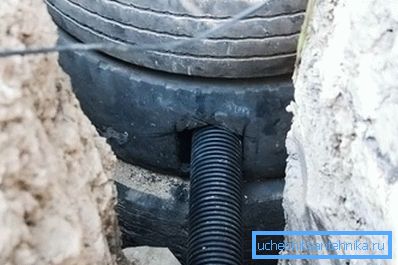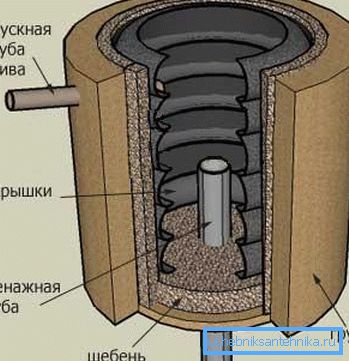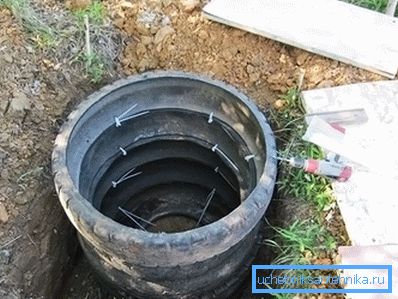Tire septic tank
Country real estate, whether it is a village or country house, as a rule, is characterized by the absence of a centralized sewerage system. However, the problem of disposal of wastewater and other impurities must be solved. The usual cesspool is the last century. It does not meet the requirements of aesthetics, comfort, ecology. Factory autonomous systems for processing and utilization of waste require financial investments for their construction and arrangement on the site. Building a complete cleaning system with your own hands is a very laborious process. To solve the issue of wastewater treatment with limited resources, you can, if you build a septic tank of tires with your own hands.
Advantages and disadvantages

When choosing a method for arranging a wastewater disposal system for a house, the positive and negative sides of each option are considered, after comparing which the choice is made.
The advantages of a septic tank of tires:
- Minimum financial costs for materials. Used tires can be purchased for a minimum amount or get for free. Having your own tires in sufficient quantities simplifies the task of finding materials.
- Simple design, ease of installation of a septic tank. One person without assistance will cope with the arrangement of autonomous sewage.
- Low labor intensity and speed of construction.
Disadvantages septic tank:
- The amount of recycled waste is limited. The autonomous system does not allow to remove waste when year-round living more than two people.
- In winter, there is a high probability of the system freezing, regardless of the presence of insulation, which makes it impossible for a person to live normally in the house.
- The need for periodic maintenance, which means pumping waste at least once a quarter.
- The cost of maintaining the system using an aspenser machine.
- System leakage. Permanent check for leaks. High probability of contamination of soil and aquifers.
- Short service life. Not more than 10-15 years.
Disadvantages significantly overlap the advantages of the system of tires, so such a septic tank is constructed in the absence of finances and the need to quickly resolve the issue of sewage.
Most often, a septic tank of tires installed for home, bath, or giving a day off in the summer.
Application Restrictions

The design features and the presence of deficiencies impose certain restrictions on the use of the tire waste treatment system.
Lack of tightness for a long time is the reason for installing the system only at very low groundwater levels.
The soils directly adjacent to the septic tank should filter water well (sand, sandy loam). In addition, these septic tanks are equipped in areas with a low level of soil freezing.
System device

The variant of autonomous sewage with the use of tires belongs to the primitive structures and is slightly different from the usual cesspool. A septic tank may consist of one or two chambers. Waste for primary processing enters the first chamber through the sewer pipe. Heavy fractions settle to the bottom. There is a partial biological processing.
Since there is no bottom in the chamber, it is recommended to lay tires on the clay layer to prevent contaminating sediments from entering the soil.

The second chamber through the overflow pipe is filled with the liquid component when filling the first chamber. It is followed by further biological processing and filtration to drain liquid into the soil through drainage.
Mounting construction

When installing the sewage system, it is necessary to take into account the design features in order to know how to make the system as reliable and safe for the environment as possible. The dimension of the tires determines the volume of earthworks. When using passenger tires, a septic tank of 5 to 7 pieces is required per chamber, and when using truck tires, 3–4 tires stacked on top of each other are sufficient.

Having marked the place for the future septic tank, a excavation depth of 1.5–2 m is digging. The perimeter of the excavation should be sufficient to accommodate two wells of tires. A layer of clay is placed under the first chamber or a concrete pad is poured. A sand cushion, not less than 20 cm high, is poured under the second camera. You can watch the video on how to make a septic tank correctly.
Tires are cut side parts on both sides, except the first and last, in which the "side" is cut only on one side. Tires are stacked exactly on top of each other and are fastened together with a wire through punctured holes. Compounds can be lubricated with a sealant or cemented to minimize the risk of waste leaking.

A sewer pipe is supplied to the chambers, and cuts are made in necessary places on tires, including for the overflow pipe. The wells are closed with a lid of any material (metal, plastic, wood). The septic tank is filled up and, if necessary, insulated.
Video
A practical lesson on how to make a tire septic tank with your own hands, you can get by watching the video: